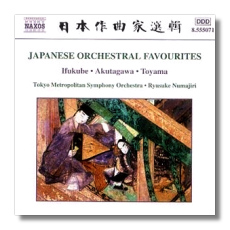
The Internet's Premier Classical Music Source
Related Links
- Latest Reviews
- More Reviews
-
By Composer
-
Collections
DVD & Blu-ray
Books
Concert Reviews
Articles/Interviews
Software
Audio
Search Amazon
Recommended Links
Site News
 CD Review
CD Review
Japanese Orchestral Favorites

- Yuzo Toyama: Rhapsody for Orchestra
- Hidemaro Konoye: Etenraku
- Akira Ifukube: Japanese Rhapsody
- Yasushi Akutagawa: Music for Symphony Orchestra
- Kiyoshige Koyama: Kobiki-Uta for Orchestra
- Takashi Yoshimatsu: Threnody to Toki
Tokyo Metropolitan Symphony Orchestra/Ryusuke Numajiri
Naxos 8.555071 DDD 65:41
Although the Japanese people tend to know a lot about Western classical music, Western listeners haven't returned the courtesy. (Takemitsu's music is the exception that proves the rule.) A disc with the title Japanese Orchestral Favorites begs the question, "Whose favorites?" Of the six works on this CD, I'd previously heard a grand total of three. I consider it my good fortune that this new release has added to my musical education.
Naxos' booklet notes tell us the first Japanese work for "European-style orchestra" was written as recently as 1921. That doesn't mean the work sounds "European," though. The composer may or may not choose to use Japanese melodies, or, more specifically, the pentatonic (whole note) scale (for example, C-D-E-F#-G#-A#-C) in his or her work. This scale, rightly or wrongly, has signified Asia in nearly every Hollywood epic since films had scores. Almost from the get-go, works such as Yuzo Toyama's Rhapsody (1960) and Hidemaro Konoye's 1931 arrangement of Etenraku (an ancient Chinese or Japanese song) sound like what we label as Japanese music. The former is a kinetically exciting showpiece – very athletic, but with a quiet middle section – and the latter is based (hypnotically) on gagaku music from the Japanese Imperial court. (The last work used to be in Stokowski's repertoire.) Akira Ifukube's percussion-rich Japanese Rhapsody (1935) melds folk-style melodies with the Stravinsky of The Rite of Spring or the Prokofieff of the Scythian Suite to piquant effect.
Yasushi Akutagawa's Music for Symphony Orchestra (1950) is something else entirely. The first section, an Andantino, is quietly cheeky, but with a coolly melancholy middle section. Again, Prokofieff comes to mind, but this time without the overtly Japanese elements. That impression is strengthened by the succeeding Allegro, a riotous knees-up that might have been written by Shostakovich, had he scored a Keystone Kops movie. (I also thought of the end of Fellini's 8½, as scored by Nino Rota.)
Kobiki-Uta is a woodcutter's song. In Kiyoshige Koyama's 1957 variations on the same, a cello starts by "singing" the song to string and brass punctuations that eerily mimic the sound of an electric saw. Successive variations place the song in more traditional settings, with lots of interesting, heavy rhythms for the drums and other percussion instruments. An unsteady trombone solo suggests that one of the woodcutters has overindulged in sake.
Threnody to Toki (1980) is Takashi Yoshimatsu's heartfelt plea for the restoration of beauty – as symbolized by the crested ibis - as an artistic virtue. (Yoshimatsu, something of a reactionary, is regarded as a neo-romantic.) Paradoxically, this is the most modern-sounding work on this CD, although – in its closeness to Takemitsu – it is absolutely gorgeous. No question here about Yoshimatsu's commitment to beauty. (Listeners who are intrigued should investigate a series of Chandos discs devoted to this composer.)
The performances are superb – poetic where poetry is needed and lusty when required – and the Naxos engineering is top-of-the-line. This CD is an excellent antidote to overly familiar music and excessively touted "superstars."
Copyright © 2002, Raymond Tuttle


















